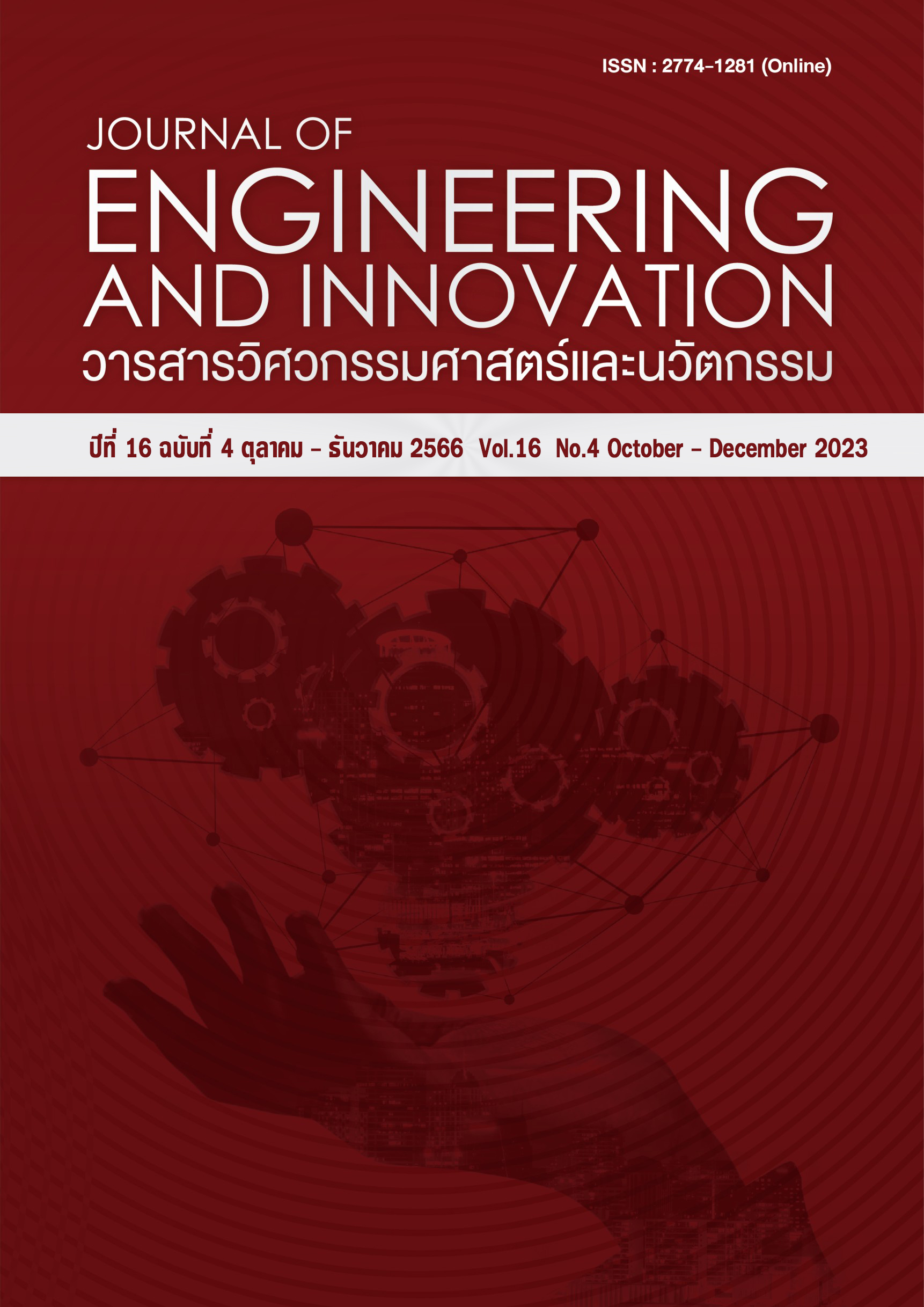Production line balancing gas stove parts forming process with ECRS principles case study: a sample company
Main Article Content
Abstract
The sample factory has taken over the production of gas burner components to pass on to the assembly department of the company due to the work that cannot be delivered to customers on time. The sample factory now has 26 working days per month and a total production order of 7,500 pieces per month, or approximately 289 pieces per day, but its production capability can only create 226 pieces per day, or approximately 5,876 pieces per month, on a typical 8-hour workday. They must therefore add 2 hours of additional extra work each day. The objective of this research is to improve the production process to reduce overtime hours by implementing the production line balancing technique. The process begins with gathering production information using process flow charts to determine the standard time, which is 8 hours each day. Utilize the comparison to determine the production cycle time at each stage, and if the value is exceeded, conduct a root cause analysis with the help of new quality control tools. Finally, balance the production line by applying the ECRS concept. The results demonstrated that it is possible to control the production cycle time to be less than the rate of takt time at each workstation. A production capacity increase of 7,696 pieces per month during regular working hours of eight hours per day is possible by reducing the number of workstations by two, or 22.22%, the number of personnel by eight, or 38.09%, and the total production cycle time by 1.71 minutes, or 14.39%. Production line efficiency grew by 33.04%, while productivity increased by 1.47% piece/hour/person, amounting to an increase of 106.52%.
Article Details
References
งานวิจัยกรุงศรี. แนวโน้มธุรกิจและอุตสาหกรรมไทยปี 2565-2567. เข้าถึงได้จาก: https://www.krungsri. com/th/research/industry/summary-outlook/out look-2022-2024 [เข้าถึงเมื่อวันที่ 18 กรกฎาคม 2565]
Kingkaew, C. Development of Production Processes Management System for Dried Parawood. Master of Engineering. Thesis in Industrial Engineering Prince of Songkla University. 2005.
วิชญา จันทนา, วัชรพจน์ ทรัพย์สงวนบุญ. การปรับปรุงประสิทธิภาพกระบวนการผลิตเซรามิค: กรณีศึกษาโรงงานในจังหวัดสมุทรปราการ. วารสารวิทยาการจัดการ มอ. 2563; 37(2): 58-83.
นงลักษณ์ นิมิตภูวดล, การลดความสูญเปล่าในกระบวนการคลังสินค้าด้วยแนวคิดลีน: กรณีศึกษา อุตสาหกรรมเฟอร์นิเจอร์. วารสารการจัดการ คณะวิทยาการจัดการ มรภ.ลป. 2557; 7(2): 66-72.
จิรวัฒน์ วรวิชัย, ปรียานุช เมฆฉาย, ธนารักษ์ สายเปลี่ยน, กานต์ วิรุณพันธ์. การปรับปรุงกระบวนการบรรจุชิ้นงานขึ้นรูปพลาสติกของชิ้นส่วนรถจักรยานยนต์. ใน: การประชุมวิชาการราชมงคลด้านเทคโนโลยีการผลิตและการจัดการ ประจำปี 2665 นครราชสีมา. 2565. หน้า 22-28.
โยชิโนบุ นายาทานิ. 7 New QC Tools เครื่องมือสู่คุณภาพยุคใหม่กรุงเทพฯ: สมาคมส่งเสริมเทคโนโลยี (ไทย-ญี่ปุ่น). เข้าถึงได้จาก: http://lib.neu.ac.th/ ULIB/dublin.php?ID=3180 [เข้าถึงเมื่อวันที่ 22 กรกฎาคม 2565]
ยุทธณรงค์ จงจันทร์, เมธี พรหมศิลา, ภีม พรประเสริฐ, กิ่งกาญจน์ กิตติสุนทโรภาศ. การลดเวลาสูญเปล่าในกระบวนการอบสีรถยนต์. ใน: การประชุมวิชาการราชมงคลด้านเทคโนโลยีการผลิตและการจัดการ ประจำปี 2565 นครราชสีมา. 2565. หน้า 133-140.
วิทยา อินทร์สอน. ทำความเข้าใจแนวคิดของการเพิ่มผลผลิต. ข่าวสารเพื่อการปรับตัวก้าวทันเทคโนโลยีอุตสาหกรรม. วารสาร Industrial Technology Review. 2558. หน้า 22.
เกียรติศักดิ์ จันทร์แดง. การบริหารการผลิตและการปฏิบัติการ. กรุงเทพฯ: วิตตี้กรุ๊ป; 2549.
วรินทร์ เกียรตินุกูล. การจัดสมดุลสายการผลิตกระบวนการประกอบโครงอลูมิเนียม กรณีศึกษา: บริษัทตัวอย่าง. วารสารข่ายงานวิศวกรรมอุตสาหการไทย. มกราคม-มิถุนายน 2561; 4(1): 49-58.
ธัชณนท์ แดนเขต, ธนภัทร แซ่ลี้, ชาณิดา พิทยานนท์. การจัดสมดุลสายการผลิตเพื่อลดความสูญเปล่าในกระบวนการผลิต กรณีศึกษา: โรงงานปลาแซลมอนแช่แข็ง. ใน: การประชุมวิชาการข่ายงานวิศวกรรม อุตสาหการ ประจำปี 2561 อุบลราชธานี. หน้า 1,092-1,096.
Sangthep, C., & Pitayachaval, P. (2020). Productivity Improvement for Lamp Assembly Process Electronics Industry. System engineering program, School of industrial engineering, Institute of engineering, Suranaree of Technology.
Pertiwi, A.F.O., & Astuti, R.D. (2020). Increased Line Efficiency by Improved Work Methods with the ECRS Concept in A Washing Machine Production: A Case Study. Jurnal Sistem dan Manajemen Industri, 4(1). pp. 13-19.

